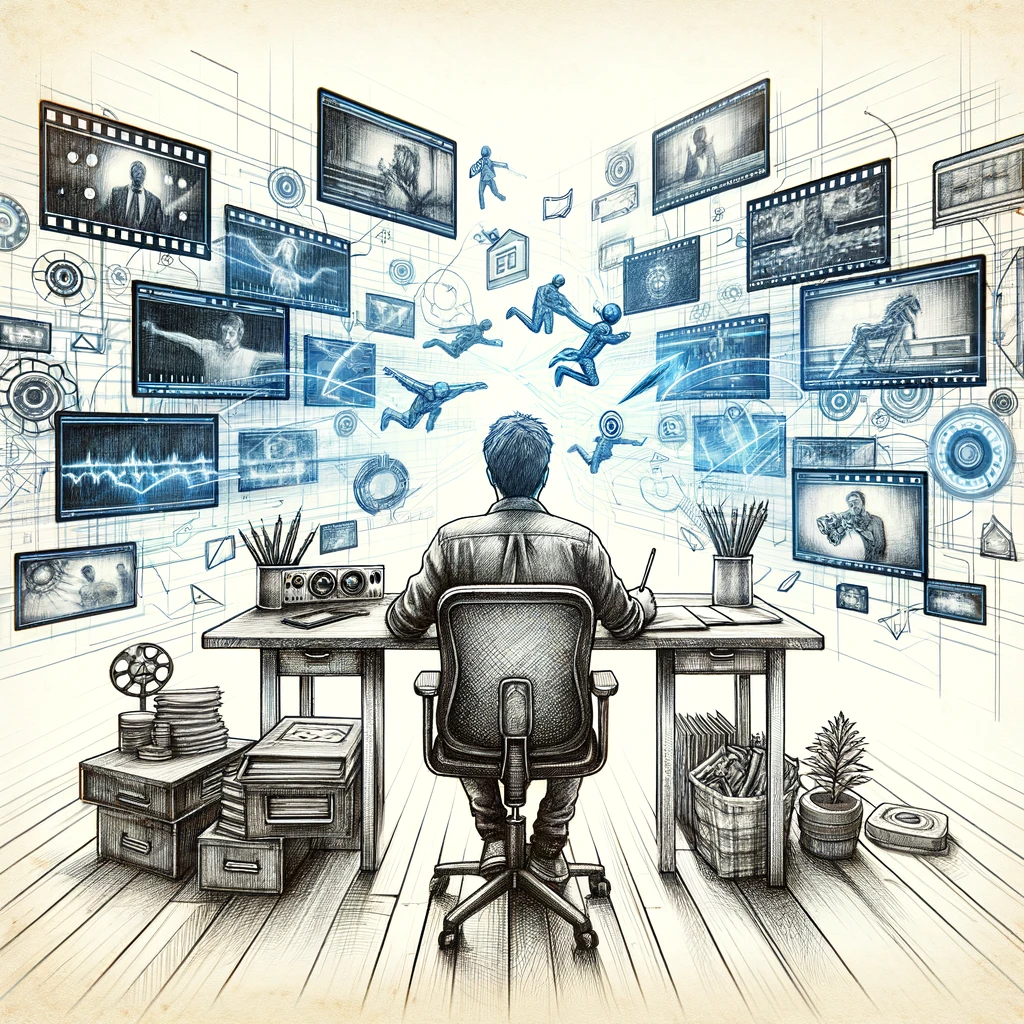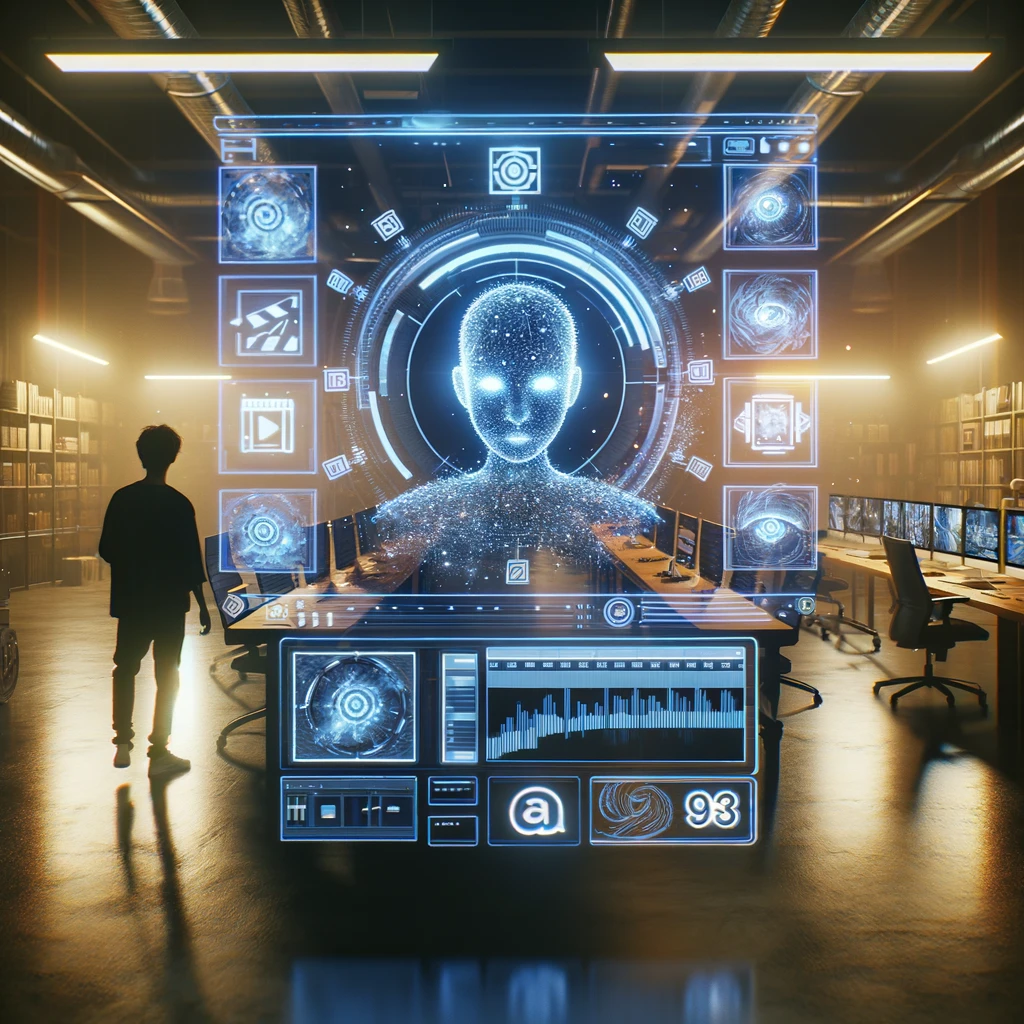A deep-dive into Sora, OpenAI’s pioneering text-to-video model, transforming the filmmaking landscape with its innovative AI-driven capabilities.

In an era where digital innovation shapes the narrative of creative industries, OpenAI introduces Sora, a cutting-edge development poised to redefine the realms of artificial intelligence and filmmaking. This text-to-video model, characterized by its ability to generate videos from textual prompts, marks a significant milestone in AI’s role within creative processes. Sora is not just a technological advancement; it is a bridge to uncharted territories of imagination, offering filmmakers a novel canvas to storyboard, visualize, and bring their cinematic visions to life with unprecedented precision and creativity.
Sora is enabling creators to simulate the complexity of real-world interactions through the simplicity of text prompts. This exploration ventures into the technological underpinnings of Sora, its transformative potential for filmmakers, the challenges it presents, and the ethical considerations of AI in creative production where imagination meets the infinite possibilities of AI.
What is Sora?
Sora, introduced by OpenAI, represents a groundbreaking leap in artificial intelligence’s application within the creative and filmmaking industries. At its core, Sora is a text-to-video model that empowers users to generate videos up to a minute long from simple text prompts. This capability signifies a monumental shift, offering a tool that can visualize complex scenarios, characters, and environments with a fidelity and ease previously unattainable.
Imagine the possibility of bringing a script to life without the need for extensive production resources, or visualizing a concept for a film with just a few lines of descriptive text. Sora’s technology is built on a sophisticated AI framework that understands and simulates the physical world in motion, reflecting OpenAI’s commitment to creating models that assist in solving real-world problems through AI-driven interactions.
This model’s introduction to the public and its potential applications in filmmaking and beyond underscore a significant moment in the evolution of AI technologies. Sora is not merely a tool for generating content but a step towards a future where AI collaborates with humans to expand the boundaries of creativity and innovation.

The Technology Behind Sora
The magic of Sora lies in its sophisticated use of diffusion models, a class of generative models that transform random noise into detailed images and videos. This process, akin to an artist refining a sketch into a detailed painting, allows Sora to produce videos that maintain visual quality and adherence to the user’s prompts.
Sora’s technology is a marvel of engineering, combining the principles of large language models (LLMs) with advancements in image and video generation. It uses a transformer architecture, renowned for its scalability and effectiveness in handling complex sequences, to process and generate visual content. This architecture enables Sora to understand the nuances of language prompts and translate them into dynamic, coherent video content.
By representing videos and images as collections of smaller data units, akin to how words form sentences, Sora can manipulate visual data with remarkable flexibility. This approach allows for the generation of content across various durations, resolutions, and aspect ratios, showcasing the model’s adaptability to diverse creative needs.
Sora’s Applications in Filmmaking
Sora’s introduction heralds a new era for filmmakers, offering a suite of possibilities that range from conceptual visualization to post-production enhancements. Its ability to generate detailed, dynamic scenes from textual descriptions opens up new avenues for storytelling, allowing filmmakers to experiment with visual styles, settings, and narratives without the constraints of traditional production resources.
Pre-visualization, a critical phase in filmmaking, can benefit immensely from Sora. Directors and cinematographers can use the model to visualize scenes, set designs, and camera movements, making the pre-production process more efficient and creative. Additionally, Sora can aid in creating visual effects, animations, and background scenes, reducing reliance on expensive CGI and animation studios.
For independent filmmakers, Sora levels the playing field, providing access to high-quality visual storytelling tools that were previously out of reach. This democratization could spur a wave of innovation in film and media, enabling a broader range of voices and visions to be brought to the screen.
Real-World Examples of Sora in Action
To grasp the full potential of Sora, consider its application across various prompts that range from fantastical scenarios to realistic simulations. For instance, a filmmaker can input a description of a bustling cityscape at night, and Sora can generate a video that captures the neon-lit vibrancy and dynamic atmosphere of the scene. Similarly, a historical drama might require scenes of ancient civilizations, where Sora can provide realistic, detailed backdrops that enhance the storytelling.
These examples highlight Sora’s versatility and its potential to revolutionize the way filmmakers approach the creative process. By bridging the gap between imagination and visual representation, Sora enables creators to explore new narratives and visual styles, pushing the boundaries of what’s possible in filmmaking.
Challenges and Limitations
Despite its groundbreaking capabilities, Sora is not without its challenges and limitations. Accurately simulating the physics of complex scenes, ensuring consistency in long-duration videos, and interpreting highly specific user prompts are areas where Sora can struggle, which can result in videos that sometimes feel unrealistic or fail to capture the nuances of real-world dynamics. This limitation points to the difficulty of encoding the vast array of physical laws and interactions into a model that also prioritizes creativity and adherence to textual prompts.
Another notable challenge is maintaining spatial and temporal consistency across longer videos. For instance, objects or characters might appear slightly different each time they come into frame, or a sequence of actions might not follow a logically coherent order. These inconsistencies, while often minor, can detract from the immersive quality of the generated content and highlight the gaps in the model’s understanding of continuous narratives and complex interactions.
Additionally, Sora sometimes struggles with very specific or nuanced prompts, reflecting the challenge of translating the rich and varied language of human creativity into visual content. While the model can generate impressive responses to a wide range of prompts, its outputs may occasionally miss the mark when faced with highly detailed or abstract requests. These challenges underscore the ongoing nature of AI development; each breakthrough comes with new obstacles to overcome and opportunities for improvement. Addressing these limitations requires continuous research, refinement, and perhaps most importantly, feedback from users and creators who push the model to its limits through creative application.
Safety Measures and Ethical Considerations
In deploying Sora, OpenAI has taken significant steps to address safety and ethical considerations. Through red teaming, the development of detection classifiers, and adherence to strict usage policies, OpenAI aims to ensure that Sora is used responsibly and creatively. These measures reflect a broader commitment within the AI community to navigate the ethical implications of advanced AI technologies, especially in fields as impactful as filmmaking.
OpenAI recognizes the profound implications of deploying advanced AI models like Sora within creative industries and the broader society. As such, several important safety measures and ethical considerations have been integrated into the development and release of Sora to mitigate potential risks and ensure responsible use.
One key initiative is the collaboration with red teamers—experts tasked with testing the model to identify vulnerabilities, potential for misuse, and areas where bias or harmful content could arise. This proactive approach to safety is designed to anticipate and address problems before they reach users, ensuring a safer interaction with the technology.
In addition to red teaming, OpenAI has developed detection classifiers capable of identifying content generated by Sora. This tool is part of a broader effort to distinguish AI-generated videos from real footage, a critical step in preventing misinformation and ensuring transparency about the origin of digital content.
Moreover, OpenAI plans to incorporate C2PA metadata in future releases, providing a digital fingerprint for content generated by Sora. This metadata initiative is part of a larger industry movement towards ensuring content authenticity and combating the spread of deepfakes and other forms of synthetic media.
These safety measures, along with the ongoing development of new techniques and the application of existing protocols from other OpenAI products, reflect a comprehensive approach to the ethical deployment of AI technologies. By engaging with policymakers, educators, artists, and the public, OpenAI aims to foster a dialogue about the positive use cases of models like Sora while addressing concerns about misuse and ethical challenges.
Sora’s Role in the Future of Filmmaking
As Sora continues to evolve, its potential impact on the filmmaking industry and beyond becomes increasingly evident. The model’s ability to generate detailed, dynamic video content from textual prompts offers a glimpse into a future where the boundaries between imagination and visual representation are seamlessly blended.
For filmmakers, Sora represents an opportunity to explore new creative horizons, reduce production costs, and democratize access to high-quality visual effects and animations. Independent creators, in particular, may find in Sora a powerful ally that levels the playing field, allowing for the production of visually stunning videos without the need for extensive resources.
Beyond individual projects, Sora’s implications for the industry as a whole are profound. The model could potentially transform pre-production processes, such as storyboarding and concept visualization, making them more efficient and accessible. It might also inspire new genres and storytelling techniques that leverage the capabilities of AI-driven content generation.
However, the integration of Sora and similar technologies into the filmmaking process also raises important questions about authorship, creativity, and the role of AI in artistic expression. These discussions are vital as the industry navigates the possibilities and challenges presented by AI, ensuring that technology enhances rather than diminishes the human element of storytelling.
As we look to the future, Sora stands not just as a technological achievement, but as a catalyst for reimagining the art of filmmaking. Its development reflects a broader trend towards the convergence of technology and creativity, opening doors to new forms of expression and storytelling that were previously unimaginable.
Comparison with Existing Technologies
Sora’s emergence in the realm of artificial intelligence and video generation presents an interesting juxtaposition against existing technologies in the film and animation industries. Traditional CGI (Computer-Generated Imagery) and animation workflows involve extensive manual labor, sophisticated software, and, often, significant financial investment. These processes, while powerful and flexible, demand a high level of skill and time to produce the desired visual effects or animated sequences.
In contrast, Sora leverages AI to streamline the creation of video content, offering a faster and more intuitive method for generating pre-visual materials. Unlike the procedural or manual crafting required in CGI and traditional animation, Sora can produce complex scenes and animations from simple text prompts. This represents a paradigm shift in content creation, where the barrier to entry is lowered, making high-quality video production more accessible to a broader range of creators.
But, it’s important to recognize that Sora is not a direct replacement for CGI and traditional animation but rather a complementary tool that offers new possibilities. For instance, Sora might be used for rapid prototyping of scenes or for generating background visuals, allowing human artists to focus on elements that need finer detail or creative input. This synergy between AI-generated content and human creativity could enrich the filmmaking process, offering the best of both worlds.
How Filmmakers Can Access and Use Sora
For filmmakers interested in exploring the capabilities of Sora, access is being granted to a select group of visual artists, designers, and filmmakers to gather feedback and refine the model. OpenAI’s approach to rolling out access is cautious, aiming to ensure that Sora is used responsibly and effectively in creative processes.
Filmmakers and content creators can stay informed about Sora through OpenAI’s official communications and apply for access if OpenAI opens the platform to wider participation. Utilizing Sora in filmmaking involves a learning curve, as creators will need to understand how to craft prompts that effectively communicate their vision to the AI. Experimentation and collaboration with the AI model will be key in harnessing its full potential.
As Sora becomes more widely available, it could be integrated into various stages of the filmmaking process, from initial concept development to post-production effects. The model’s ability to quickly generate video content based on text prompts makes it a valuable tool for exploring visual ideas, testing out different scenarios, or even creating final animations for use in films.
Potential for Education and Training
Sora’s implications extend beyond professional filmmaking into the realms of education and training. Film schools and educational programs can incorporate Sora into their curriculum, offering students a hands-on experience with AI-driven video generation. This exposure can provide valuable insights into the future of filmmaking, where understanding and collaborating with AI will be an essential skill.
Moreover, Sora can serve as a training tool, allowing students to experiment with visual storytelling, understand the nuances of visual effects, and explore the intersection of technology and art. By democratizing access to high-quality video generation, Sora can inspire a new generation of filmmakers to push the boundaries of creativity and innovation.
Impact on Independent Filmmakers
Independent filmmakers stand to gain significantly from the advent of Sora. The technology’s ability to generate detailed, high-quality video content from textual prompts can open up new creative possibilities for indie creators, who often work with limited budgets and resources. Sora can help level the playing field, providing independent filmmakers with access to visual effects and animations that would otherwise be cost-prohibitive.
This democratization of content creation tools could lead to a surge in innovative and diverse storytelling, as indie filmmakers are empowered to realize their visions without the constraints of traditional production processes. By reducing the barriers to high-quality video production, Sora has the potential to foster a more inclusive and varied cinematic landscape.
Case Studies
While specific case studies of Sora’s application in filmmaking are yet to be widely published, the potential for its use in real-world projects is vast. From creating dynamic backgrounds for low-budget indie films to enabling solo creators to produce complex animated sequences, Sora’s technology promises to be a game-changer. Future case studies will likely showcase how filmmakers have harnessed Sora to overcome creative and logistical challenges, pushing the boundaries of what’s possible in independent and experimental cinema.
Future Developments and Research
As Sora continues to evolve, OpenAI’s ongoing research and development efforts will focus on addressing the current limitations and expanding the model’s capabilities. Future developments may include improved understanding of complex prompts, enhanced simulation of physical interactions, and more sophisticated safety measures to prevent misuse.
The continued refinement of Sora, guided by feedback from the filmmaking community and advances in AI research, will shape the trajectory of this technology. As we look forward, the integration of Sora into the filmmaking process heralds a new era of creative potential, where the power of AI is harnessed to enrich and diversify the world of cinema.
A Collaborative Future
The future of Sora and AI in filmmaking is not just about technological advancement but also about fostering a collaborative ecosystem where AI serves as a co-creator, enhancing human creativity rather than replacing it. The dialogue between AI developers, filmmakers, artists, and the audience will be crucial in shaping a future where technology and creativity coalesce to enrich human experiences and storytelling.
FAQs about OpenAI’s Sora for Filmmakers
How does Sora differentiate from traditional video editing software?
Sora leverages AI to generate video content from textual prompts, offering a novel approach compared to traditional video editing software, which requires manual input and manipulation of visual elements. This AI-driven model can conceptualize and produce complex scenes, potentially saving time and resources in the creative process.
Can Sora generate videos in any style?
Yes, Sora is designed to interpret and materialize a wide range of visual styles as described in text prompts. From realistic to fantastical settings, Sora’s versatility allows creators to explore various artistic directions. Yet, the fidelity to style can depend on how well the prompt is crafted and the model’s current capabilities and limitations.
What are the potential uses of Sora for independent filmmakers?
Independent filmmakers can utilize Sora to pre-visualize scenes, create dynamic backgrounds, or even generate short animated sequences. This can reduce production costs and allow for greater creative experimentation, especially for projects with limited budgets.
How can filmmakers and content creators gain access to Sora?
As of the last update, OpenAI was granting access to Sora to a select group of users for testing and feedback. Filmmakers interested in using Sora should stay informed through OpenAI’s official channels for announcements on broader access or application processes.
What are the main challenges or limitations of using Sora?
Current challenges include accurately simulating complex physical interactions, maintaining consistency in longer video sequences, and interpreting highly detailed or abstract prompts. These are areas of ongoing research and development by OpenAI.
How does OpenAI ensure the ethical use of Sora?
OpenAI has implemented several safety measures, including the development of detection classifiers to identify AI-generated content, and is engaging with experts and the community to address ethical considerations. Policies and tools are in place to prevent misuse and ensure Sora’s responsible deployment.
What future developments can we expect for Sora?
Future developments may include enhancements to Sora’s ability to understand and execute complex prompts, improvements in video realism and consistency, and expanded access for creators. OpenAI continues to research and develop AI models, focusing on safety, usability, and creative potential.
Conclusion
As we stand on the brink of a new era in filmmaking and creative expression, Sora by OpenAI emerges as a beacon of the transformative potential of AI. It offers a glimpse into a future where the boundaries between the imagined and the created blur, where stories are not just told but are vividly brought to life. The journey of Sora is a testament to the power of innovation, the spirit of collaboration, and the endless possibilities that lie at the intersection of technology and creativity. As we move forward, the narrative of Sora and its impact on the creative world continues to unfold, promising a future ripe with possibilities, challenges, and the unwavering potential to redefine the essence of storytelling and artistic expression.
